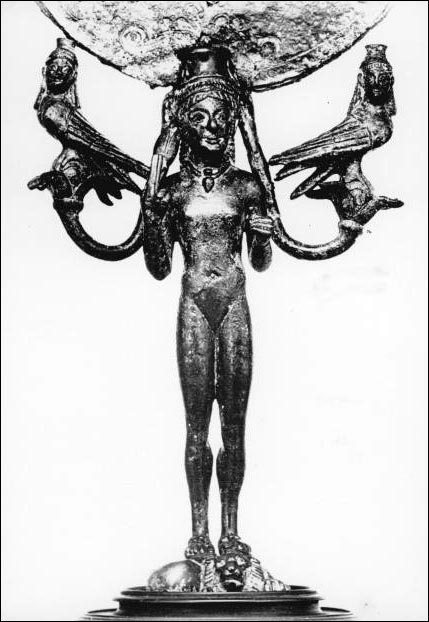 |
Date ca. 550 B.C. Origin The Classical World : Hellenic Era : Greek Archaic Period : Mainland Greece Description Nude goddess wearing circular headdress, necklace with pendant, sandals, standing on recumbent lion, holding flower in right hand, object in left; from her head volute palmettes extend at either side, connecting figure with mirror; palmettes terminate in flowers on each of which stands a human-headed bird (siren). Sirens depict soul in bird form, are reminiscent of Ba, bird-soul in Egyptian religion. The resemblance of this mirror to an Old Babylonian terra cotta plaque depicting the goddess Lilith, bringer of death, flanked by two owls is so striking as to suggest a similarity in meaning. Neumann points out that Lilith is identified with enchantment leading to doom, a quality comparable to that of the sirens in our mirror. He specifically compares the negative aspect of the goddess to that of the siren as it was recognized in Hellenistic times, approximately three hundred years later than our mirror. In this Spartan bronze the association of the Sirens, tomb haunters, and a goddess who in her pose on the lion recalls earlier depictions of the Lady of the Beasts may suggest that the sirens have not yet become independent death spirits. Some of the demonic power which we identify in Lilith is perhaps to be seen in the bronze goddess though her high headdress and the long volutes on which the birds sit. It is interesting to note that above the headdress on the mirror itself are lightly inscribed volutes which may be a decorative transformation of the horns which the prototype for this figure probably had. Object Mirror (bronze). Material or Technique Metal. Provenance From Hermione (formerly Kastri), in Argolis, Greece. Repository or Site Munich: Mus., Sammlungen Antike Kunst und Glyptothek. Image Sources a) from Neumann.* [EN:GM pl.127] b) [EA 95/49] References *Neumann, E. Great (1955), pp.xxvii,81,145-146,273; pl.127. Bülle, H., Schöne (1911-1912), pp.314-15; pl.146. Buschor, E., Musen (1944), p.30; fig.23. |